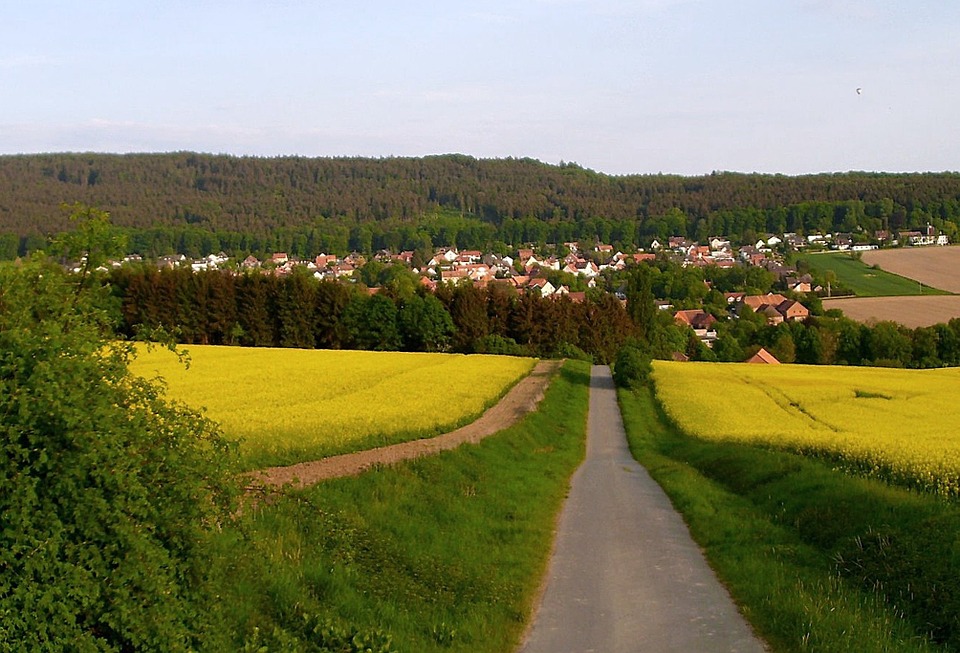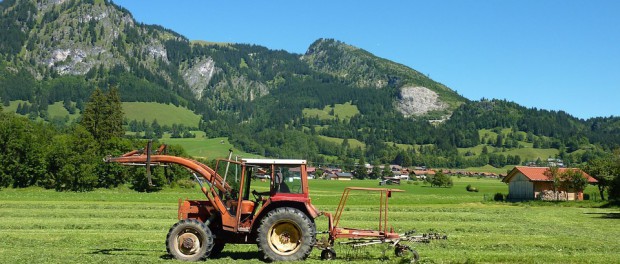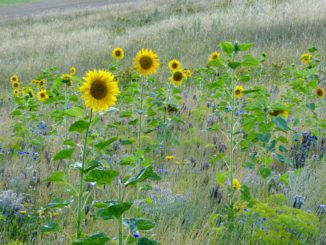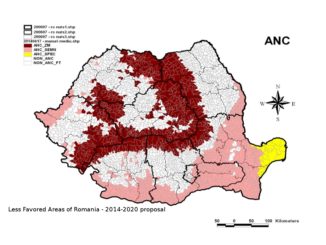Special guest post by Dr. Sebastian Lakner, Research Associate at the Chair for Agricultural Policy at the Georg-August University Göttingen. This post originally appeared on Sebastian’s blog in German.
The debate on the next reform on the common agricultural policy (CAP) 2020 in Germany is taking shape. Political actors are announcing their positions for the next reform 2020. In this post I will describe how the political actors in Germany are positioning themselves on direct payments beyond 2020. Is there momentum for change? Is support for more targeted programs and more efficient use of taxpayers money in agricultural policy emerging?

What is the objective for the next reform 2020?
The most prominent example for public goods are environmental services by farmers. If we apply this criterion on the EU’s Common Agricultural Policy (CAP), the direct payments in pillar one (P1) are not well targeted to public goods: In the CAP-reform 2013, the EU-commission attempted to link direct payments to environmental objectives, using the new concept of ‘Greening’, which so far shows almost no effect on biodiversity (See the paper of Guy Pe’er 2014 in Science). Even the most promising element of Greening, the concept of ‘Ecological Focus Area (EFA)’ was watered down in the negotiation process. Finally, in the implementation, 2015 farmers can use the less costly but also less effective measures, which will have almost no effect on biodiversity (see the post on the German data on ecological focus area 2015).
It is also the case that the income objective of direct payments is questionable, since there are no consistent complete statistics on farm incomes (including private assets and incomes from outside agriculture). At the same time, there have been only minor improvements in the Rural Development programs (ELER), the so-called second pillar (P2) of CAP.
From a public good’s perspective, these P2 programs are to an extent better targeted. However, according to the paper by Guy Pe’er and colleagues, we find some poorly targeted programs and many windfall gains for farmers. A good overview on the different CAP-instruments is the paper by Valentin Zahrnt from 2009 – ‘Public Money for Public Goods: Winners and Losers from CAP Reform’.
To sum up, the CAP (P1 and P2) needs to be better targeted and more efficient in spending taxpayers money, to achieve its stated policies regarding public services for lively rural areas and the protection of biodiversity. At the same time, farmers would like to avoid excessive bureaucracy and want to develop their farms with only a necessary level of intervention. Therefore, the next CAP reform 2020 has a long list of challenges!
Why is Germany of specific interest in the CAP?
Germany can be regarded as a centre or ‘swing-state’ within the EU-decision process: German votes can change the majority for or against a specific policy. Based on the experience of the CAP-reforms since the MacSharry Reform 1992, we can, in simplified terms, observe the following impact of Germany:
- If the German government was willing to substantially reform the CAP, the following reforms (in 1992 and 2005) brought changes and improvements towards more public goods for public money and at the same time, reduced overproduction, made CAP-spending more efficient and less market-distorting.
- In contrast, if the willingness for changes was absent in the German political landscape (as in 2000 and 2013), the following CAP-reforms did not bring substantial improvements by way of generating more public goods for public money. (For interested readers, the book of Cunha and Swinbank 2011 gives a very detailed inside in the history of CAP-reform.)
The debate in Germany is also interesting for the CAP due to its federal political structure. In the negotiation process of a reform, the Ministry of Agriculture is part of the European Council, while 99 German elected members are contributing to the position of the European Parliament. And for the implementation of a reform, the parliament (Bundestag) and the federal state parliament (Bundersrat) have to decide. At the moment, the grand coalition of Christian Democrats and Social Democrats is in power in Berlin, with the next Bundestag elections will take place in September 2017.
So is not clear what party(s) will be in power when the debate on the post-2020 CAP heats up. Furthermore, since 2011 a number of the federal states (Länder) in Germany are ruled left-wing coalitions consisting mostly of Social Democrats and Greens. Altogether, 6 of 13 state ministers of agriculture are members of the Green party. So regardless of who wins the federal election in 2017, the new government in Berlin will have to find compromises with the Social Democrats and the Greens. So again, Germany might be an interesting country to observe the prospects for the next reform.

The debate on the future of direct payment is gathering pace
- In July 2015, Robert Harbeck (state-minister for agriculture in Schleswig-Holstein and a member of the pragmatic wing of the Green Party) and Martin Häusling (agricultural speaker of the Green Party in the European Parliament) released a paper (‘Fundaments instead of pillars – Resource conserving, animal friendly and socially sustainable! Arguments for a new construction of the European agricultural policy!’, in German), which includes a critique on Greening and the direct payment of P1. Both argue in favour of a substantial reduction of direct payments and an increase of P2. However, the speaker of the Greens in the Bundestag, Friedrich Ostendorff is rather busy with other topics. Within the Green Party, the actual tendency is to maintain the sum of the agricultural payments for farmers (P1 and P2), but to also strengthen P2 in the long run. There is no cut in direct payments foreseen. But this position might change, especially after the upcoming elections in two Länder (Rhineland-Palatinate and Baden-Württemberg) in March 2016, where the Green Party is currently a coalition partner. A lot will depend on the speaker of the Green Party in the Bundestag, Toni Hofreiter from the left-wing and also Bärbel Höhn from the pragmatic wing of the party. Both will strongly influence the decision-making within the party.
- The Social democrats (SPD) are also rather critical with the direct payments in P1. In October 2015, the environmental minister, Barbara Hendricks (SPD) presented her ‘Nature conservation campaign 2020’. Here she suggests that the direct-payments should be abolished and the P2-programs for environmental protection strengthened. Her arguments resemble those of Harbeck & Häusling. However her initiative was not well coordinated, so she received little support in the media from other parties or environmental NGOs, who mostly doubted that Mrs Hendricks would be able to get the majority within the great coalition of SPD and CDU in Berlin. Other Social Democrats, such as the speaker for agricultural policy, Wilhelm Priesmeier in the Bundestag (in a public debate in Göttingen in May 2013, in German) and the minister for agriculture in the state Mecklenburg-Vorpommern, Till Backhaus (in and interview from April 2015, in German) also argue for a reduction of direct payments in P1. On the other hand the Social Democrats have no stake in agricultural policy. The main tendency of the Social Democrats is to reduce direct payments in P1 and to strengthen P2, but there are also doubts, whether the social democrats are willing to fight for a strong CAP reform 2020.
- Finance minister Wolfgang Schäuble (CDU) announced in a keynote-speech on a conference on September 22, 2015 in Brussels, that he would argue for a shift of the agricultural budget. ‘To be quite frank: I propose to use the money that is spent for cohesion policy and parts of the agriculture budget to support reform efforts in the Member States. The national projects which benefit from financing from the European funds should be systematically designed to implement the country-specific recommendations. The Commission needs to make this the precondition for financing national projects’, he said. In making this statement, he echoed what financial experts from different parties in the Bundestag and also experts from the federal ministry for finances have been arguing for many years. Their main argument is, given the different actual problems and crises in the European Union (e.g. the Euro- or the refugee-crisis), money should be spent on real financial challenges rather than a maintenance of agricultural payments. Schäuble in his speech also argued for a focussing of the budget on ‘European value added’.
- Wolfgang Schäuble is very popular within the conservative Party (Christian Democratic Union, CDU), however he is not responsible for agricultural policy. The main position of the CDU is a maintenance of the current system of direct payments. The minister for farming, Christian Schmidt (CSU, the Bavarian part of the CDU) in a speech of April 2014 mainly defended the main decisions of the CAP-Reform 2013 in the Bundestag (See speech of 03.04.2014, in German). On a parliamentary request of ‘The Left’ (by Kirsten Tackmann), he declined to give a clear position for the CAP-reform 2020. Georg Nüßlein (CDU, and vice-speaker of the CDU-Group in the Bundestag) in a reaction to Mrs Hendricks on October 14, 2015 (in German) also argued in favour of a consequent implementation of Greening and the maintenance of direct payment beyond 2020. This can basically be described as the position of the conservative party. However, there are individuals with different arguments. CDU member of European Parliament, Peter Jahr said on September 16, 2015 at a roundtable for the future of CAP (in German) that we need to rethink the system of direct payment. His argument is that P1 is just to support competitiveness of farms, and that agri-environmental policy should take place in P2. Hans Georg von der Marwitz (CDU) argued similarly in a public debate in Göttingen in May 2013 (in German): He is in favour of a stepwise reduction of direct payment, however he has admitted that his position is not supported by a majority in his own party. So the main tendency of CDU/CSU is to maintain direct payments after 2020.
- The position of The Left (Die Linke) is not quite clear at the moment: Kirsten Tackmann (Speaker for agriculture in the Bundestag) has been critical of how the CAP functions during recent years. However, in a press release on the topic of Ecological Focus Area (EFA) they claimed that Greening and EFA supports the diversity in agricultural landscapes. Taking the real value of EFA in Germany (e.g. presented on Lakners Kommentare), this seems to be a quite optimistic view and a rather mild for an otherwise opposionist party. Besides this, her statement was also very close to the public comment on EFA of farm minister Christian Schmidt (CSU). However, the main tendency of the Left is to be rather critical of direct payments, but their signals are mixed.
- During the 1970s, the Minister of Agriculture was Joseph Ertl, a member of the liberal party (FDP). Nowadays, the liberal party is less visible in this field, maybe also due to the fact that they are not represented in the Bundestag since 2013. It is difficult to see a clear agricultural position. They are in favour of both P1 and P2 and public goods, and at the same time for strong market-orientation. Their arguments for public goods have little credibility, since in the federal states the liberals often criticise the agri-environmental schemes and the support of organic farming in P2. In case of a comeback after the next federal elections in 2017, the FDP could have two tendencies. The first tendency is to keep everything as before and the other tendency might be to cut of agricultural payments in both P1 and P2 without any replacement.
To summarize, the positions towards a reform of the CAP 2020 are not fully clear within the German parties. There is be a left-right tendency: Those who advocate cutting the direct payments come for the most part from the left of the political spectrum, while those on the right generally support the continuation of these payments. But the discussion seems to be more open than e.g. 2009/2010 and has more ‘momentum for change’. Taking the statements above, I could imagine three main scenarios for a CAP-reform 2020:
- ‘Consolidation scenario’: The CAP 2020 would maintain the actual system and implement while also sharpening the concept of greening; on the other hand there would be a simplification of Cross-Compliance – even if this sounds very contradictory. In retrospect of the first experiences with the Co-Decision in the CAP-reform 2013, this scenario is not unrealistic, even if this does not bring a more efficient CAP. In the last reform’s decision process, it was very difficult to find compromises and organize majorities among the 28 member-states in the Council of the European Union and in a very heterogeneous EU-Parliament. This scenario would rather take place with a one-party CDU-government in Germany.
- ‘Second pillar reform scenario’: A moderate reform could bring a small or substantial reduction of direct payments in P1 and an increase of P2. This could (Scenario 2a) come with a general cut of direct payments on the EU-level or by means of further redistribution between EU-member-states, so that Eastern European countries might get higher and Western European countries lower direct payment-rates. Or (scenario 2b) this reform would again introduce flexibility elements subject to national decisions (as in the CAP-reform 2013), so that a shift of P1 to P2 would depend on the implementation of national governments. This scenario would be realistic with a government of SPD-Green, but also with CDU-Green or in a great coalition with Green agricultural ministers in the federal states (as it was in 2013/14).
- ‘Reduction-scenario’: Here we would see an overall reduction of the agricultural budget. The reform might only touch the P1-direct payments or even reduce rural development programs (P2). The free money would go into other priorities within the EU like unemployment, refugees or to support countries with financial problems (as Wolfgang Schäuble has suggested). This scenario would be dominated by financial politicians like Schäuble, but also with support of liberal parties or governments (like the UK-government of David Cameron). This scenario might have a higher probability, if e.g. a majority in United Kingdom would vote in 2017 for an exit from the EU or in case of another Euro-crisis of Greece, Italy or Spain. However a crisis can also lead to a policy to avoid more conflicts with powerful stakeholders in the EU like the farmer’s associations – in other words, a desire to keep everything as stable as possible might emerge. A CDU-FDP-coalition might support this scenario, but in case of a crisis, a great coalition or CDU-Green might also go into this direction.
Overall, the whole debate on CAP 2020 is just in the beginning, so these are just broad tendencies. The described scenarios are pure speculation so far, but after the regional elections in March 2016, the whole debate in Germany might take up more speed. And so far, the positions are not as fixed as before the last reform.
Literature:
Cunha, A. und A. Swinbank (2011): An inside view of the CAP reform process. Oxford: University Press.
Pe’er, G., L.V. Dicks, P. Visconti, R. Arlettaz, A. Báldi, T. G. Benton, S. Collins, M. Dieterich, R. D. Gregory, F. Hartig, K. Henle, P. R. Hobson, D. Kleijn, R. K. Neumann, T. Robijns, J. Schmidt, A. Shwartz, W. J. Sutherland, A. Turbé, F. Wulf, A. V. Scott (2014): EU agricultural reform fails on biodiversity, in Science 344 (6188), p. 1090- 1092.
Zahrnt, V. (2009): Public Money for Public Goods: Winners and Losers from CAP Reform, ECIPE Working Paper, No. 08/2009






1 Trackback / Pingback
Comments are closed.